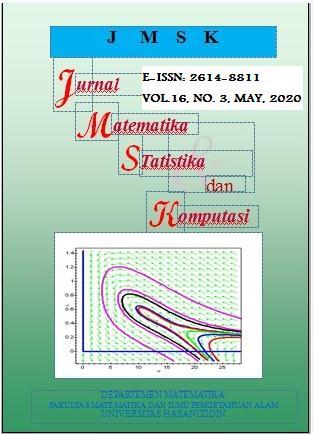Analysis of User Sentiment of Twitter to Draft KUHP
DOI:
https://doi.org/10.20956/jmsk.v16i3.8239Keywords:
Draft of KUHP, Twitter, Text Mining, Sentiment AnalysisAbstract
Twitter is one of social media where its user can share many responses for a phenomenon through a tweet. This research used 5000 tweets from Twitter users in Bahasa Indonesia with keyword “RUU KUHP(Draft Law of KUHP)” from 16th of September until 22nd of September 2019. That tweets were processed using Rstudio software with sentiment analysis that is one of Text Mining methods. This research aims to classify Twitter users’ responses to RUU KUHP to be negative sentiment, poisitive negative, and neutral. Also, this research also aims to know about topics’ frequencies that were related to RUU KUHP through visualization with bar plot and also wordcloud. This research also aims to know words that are associated with the most frequent words. Form this research, can be known that Twitter users’ responses to RUU KUHP tend to have neutral sentiment that means they did not take side between agreeing or disagreeing. From this research, also can be known about 10 most frequent words, there are kpk, tunda, dpr, pasal, kesal, jokowi, presiden, masuk, ya, and sahkan. Beside that, can be known the other words that are associated with them and also their probability.
References
Fadli, A. (2003). Konsep Data Mining. Ilmu Komputer.
Fink, C. R., Chou, D. S., Kopecky, J. J., & Llorens, A. J. (2011).
Coarse- and Fine-Grained Sentiment Analysis of Social Media Text. Johns hopkins apl technical digest, 30(1), 22-30.
Hadi, A. F., C. W., D. B., & Hasan, M. (2017). Text Mining pada Media Sosial Twitter Studi Kasus: Masa Tenang Pilkada DKI 2017 Putaran 2. Seminar Nasional Matematika dan Aplikasinya (hal. 324-331). Surabaya: Universitas Airlangga.
Hadna, N. M. S., Santosa, P. I., & Winarno, W. W. (2016). Studi Literatur Tentang Perbandingan Metode untuk Proses Analisis Sentimen di Twitter. Semin. Nas. Teknol. Inf. dan Komun, 2016, 57-64.
Hidayatullah, A. F., & SN, A. (2014). Analisis Sentimen dan Klasifikasi Kategori Terhadap Tokoh Publik pada Twitter. Seminar Nasional Informatika (hal. 115-122). Yogyakarta: UPN "Veteran" Yogyakarta.
Indraloka, D. S., & Santosa, B. (2017). Penerapan Text Mining untuk Melakukan Clustering Data Tweet Shopee Indonesia. JURNAL SAINS DAN SENI ITS, 6, A51-A56.
Karyadi, S., Yasin, H., & Mukid, M. A. (2016). Analisis Kecenderungan Informasi Dengan Menggunakan Metode Text Mining (Studi Kasus: Akun Twitter @detikcom). Jurnal Gaussian, 5, 763-770.
Kemp, S. (2019, January 31). Digital 2019: Indonesia. Dipetik September 27, 2019, dari Data Reportal: https://datareportal.com/reports/digital-2019-indonesia
Liu, B. (2012). Sentiment analysis and opinion mining. Synthesis lectures on human language technologies, 5(1), 1-167.
Pramana S., Yuniarto B., Mariyah S., Santoso, I., dan Nooraeni R. 2018. Data Mining dengan R Konsep Serta Implementasi. Jakarta : InMedia.
Ridwan, M., Suyono, H., & Sarosa, M. (2013). Penerapan Data Mining Untuk Evaluasi Kinerja Akademik Mahasiswa Menggunakan Algoritma Naive Bayes Classifier. Jurnal EECCIS, 7(1), 59-64.
Ulfah, E. N. (2016). URGENSI PEMBARUAN KITAB UNDANG-UNDANG HUKUM PIDANA :ANALISIS KAJIAN PERKARA NO 46/PUU-XIV/2016. Indonesian Journal of Criminal Law Studies, 72-86.
Downloads
Published
How to Cite
Issue
Section
License

This work is licensed under a Creative Commons Attribution 4.0 International License.
Jurnal Matematika, Statistika dan Komputasi is an Open Access journal, all articles are distributed under the terms of the Creative Commons Attribution License, allowing third parties to copy and redistribute the material in any medium or format, transform, and build upon the material, provided the original work is properly cited and states its license. This license allows authors and readers to use all articles, data sets, graphics and appendices in data mining applications, search engines, web sites, blogs and other platforms by providing appropriate reference.







